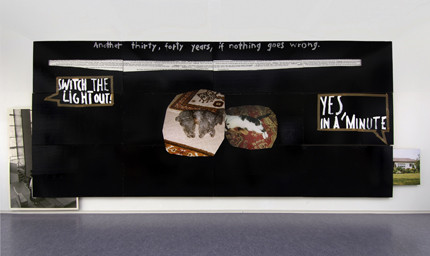Carte Blanche VII
Gallery EIGEN + ART
20 Jun - 16 Aug 2009
The focus of the EIGEN+ART exhibition will be the gallery’s participation in art fairs, as such fairs form an important part of the gallery year. The gallery, with locations in Leipzig and Berlin, takes part in the five most important fairs: Art Miami Basel, Art Basel, Art Forum Berlin, the Frieze in London and the Armory Show in New York City. Gerd Harry Lybke pursues different exhibition strategies at each fair: solo and group exhibitions, thematic presentations, sometimes he focuses on stars, and at other times on less established artists. The strategies that underlie this business model are put forward for discussion in the form of five presentations. A discursive programme including fair directors, the gallery association and businesses is planned to accompany the exhibition.
EIGEN+ART is one of Germany’s most successful galleries today. It was founded by Gerd Harry Lybke, who began exhibiting works by his artist friends in his apartment at Körnerplatz 8 in Leipzig in 1983. His first exhibition, which marked the birth of Galerie EIGEN+ART, was titled “Die neuen Unkonkreten” (The New Obscures). In the spring of 1990, Lybke and some of the gallery’s artists participated in their first fair, the Art Frankfurt. Although video art was the prevailing form in Frankfurt am Main at the time, EIGEN+ART’s first fair appearance, with paintings, drawings and installations by such artists as Carsten Nicolai, Olaf Nicolai and Jörg Herold, was more than just a commercial success. Since then Lybke has exhibited the work of his artists at the most internationally important fairs. The gallery expanded its presence throughout the '90s with temporary galleries worldwide, beginning in Tokyo in 1990 and followed by Paris (1991), Berlin (1992), New York (1993) and London (1994). The second Galerie EIGEN+ART grew out of the temporary gallery in Berlin. Through these temporary galleries, Lybke was able to make his artists known in the then most important art cities. And by 1997 five of his artists exhibited at the documenta in Kassel.
The Galerie EIGEN+ART represents: Ákos Birkás, Birgit Brenner, Martin Eder, Tim Eitel, Nina Fischer & Maroan el Sani, Stella Hamberg, Jörg Herold, Christine Hill, Uwe Kowski, Rémy Markowitsch, Maix Mayer, Carsten Nicolai, Olaf Nicolai, Neo Rauch, Ricarda Roggan, Yehudit Sasportas, David Schnell, Annelies Strba, Matthias Weischer
Curated by Julia Schäfer
in co-operation with Gerd Harry Lybke
EIGEN+ART is one of Germany’s most successful galleries today. It was founded by Gerd Harry Lybke, who began exhibiting works by his artist friends in his apartment at Körnerplatz 8 in Leipzig in 1983. His first exhibition, which marked the birth of Galerie EIGEN+ART, was titled “Die neuen Unkonkreten” (The New Obscures). In the spring of 1990, Lybke and some of the gallery’s artists participated in their first fair, the Art Frankfurt. Although video art was the prevailing form in Frankfurt am Main at the time, EIGEN+ART’s first fair appearance, with paintings, drawings and installations by such artists as Carsten Nicolai, Olaf Nicolai and Jörg Herold, was more than just a commercial success. Since then Lybke has exhibited the work of his artists at the most internationally important fairs. The gallery expanded its presence throughout the '90s with temporary galleries worldwide, beginning in Tokyo in 1990 and followed by Paris (1991), Berlin (1992), New York (1993) and London (1994). The second Galerie EIGEN+ART grew out of the temporary gallery in Berlin. Through these temporary galleries, Lybke was able to make his artists known in the then most important art cities. And by 1997 five of his artists exhibited at the documenta in Kassel.
The Galerie EIGEN+ART represents: Ákos Birkás, Birgit Brenner, Martin Eder, Tim Eitel, Nina Fischer & Maroan el Sani, Stella Hamberg, Jörg Herold, Christine Hill, Uwe Kowski, Rémy Markowitsch, Maix Mayer, Carsten Nicolai, Olaf Nicolai, Neo Rauch, Ricarda Roggan, Yehudit Sasportas, David Schnell, Annelies Strba, Matthias Weischer
Curated by Julia Schäfer
in co-operation with Gerd Harry Lybke

